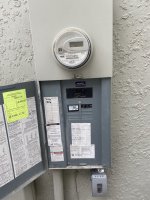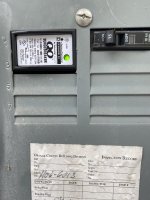Jadnashua
Retired Defense Industry Engineer xxx
Some people buy surge suppressors for things like their computers, and some might put them on their stereo or other devices, but today, many many devices have electronics in them to include stoves, refrigerators, microwave ovens, and, well, sometimes even an exhaust fan might have electronic speed controls.
So, where does that leave us?
A little info can help. The junctions in solid state devices generally don't like voltage spikes. And, just the power on/off cycling can be an issue. A power failure, when power is restored, can fluctuate considerably before it stabilizes. Ever had the lights flicker a bunch of times when things come back on? Ever noticed that all light bulbs tend to blow when you first turn them on? Those are much more robust connections than solid state devices. Well designed ones tend to have some built-in protections, but that costs money, and shortcuts are sometimes made. People have also gotten more in the mindset of just replacing the things when they start to act funky, and just accept that they don't work as reliably as they used to.
Well, there are ways to help change the odds of keeping things working longer in your favor...putting some surge suppression on your power panel. Some are designed to attach to the input power leads and they can work well, but what's adequate for most people is one designed to attach to a dual-pole breaker so it can hit both L1 and L2. Pretty simple to install, but working IN a power panel can be dangerous if you don't know what you're doing, and don't use some protection gear in the process. But, basically, many of these are designed to mount to the outside of the power panel through a knock-out, then the three leads get attached, N, L1, L2. L1 and L2 go into the new breaker, and the neutral goes to its bus connection. Most of them have an indicator LED that illuminates to tell you it's working for each of the power leads...if it ever shows one of the lamps out, that means it sacrificed itself and is no longer providing protection on that leg of the power, so it's easy to check it's working or not.
Lots of companies make these things. What you're looking for is a high surge current rating, and a short response time.
I've used this one at my mother's house after her microwave and refrigerator were damaged after a near hit by lightning...lots of storms since, and things have been stable since. I installed one over 30-years ago on my power panel, and my neighbors have had to replace some electronics over the years, but I have not, so while not an absolute guarantee of success, it seems to have worked for me. INS-730308-ST-NEMA.pdf (mersen.com)
If you're not versed in dealing with work on a power panel, pay someone that is to install one for you, but it's no worse than adding a new circuit.
So, where does that leave us?
A little info can help. The junctions in solid state devices generally don't like voltage spikes. And, just the power on/off cycling can be an issue. A power failure, when power is restored, can fluctuate considerably before it stabilizes. Ever had the lights flicker a bunch of times when things come back on? Ever noticed that all light bulbs tend to blow when you first turn them on? Those are much more robust connections than solid state devices. Well designed ones tend to have some built-in protections, but that costs money, and shortcuts are sometimes made. People have also gotten more in the mindset of just replacing the things when they start to act funky, and just accept that they don't work as reliably as they used to.
Well, there are ways to help change the odds of keeping things working longer in your favor...putting some surge suppression on your power panel. Some are designed to attach to the input power leads and they can work well, but what's adequate for most people is one designed to attach to a dual-pole breaker so it can hit both L1 and L2. Pretty simple to install, but working IN a power panel can be dangerous if you don't know what you're doing, and don't use some protection gear in the process. But, basically, many of these are designed to mount to the outside of the power panel through a knock-out, then the three leads get attached, N, L1, L2. L1 and L2 go into the new breaker, and the neutral goes to its bus connection. Most of them have an indicator LED that illuminates to tell you it's working for each of the power leads...if it ever shows one of the lamps out, that means it sacrificed itself and is no longer providing protection on that leg of the power, so it's easy to check it's working or not.
Lots of companies make these things. What you're looking for is a high surge current rating, and a short response time.
I've used this one at my mother's house after her microwave and refrigerator were damaged after a near hit by lightning...lots of storms since, and things have been stable since. I installed one over 30-years ago on my power panel, and my neighbors have had to replace some electronics over the years, but I have not, so while not an absolute guarantee of success, it seems to have worked for me. INS-730308-ST-NEMA.pdf (mersen.com)
If you're not versed in dealing with work on a power panel, pay someone that is to install one for you, but it's no worse than adding a new circuit.


